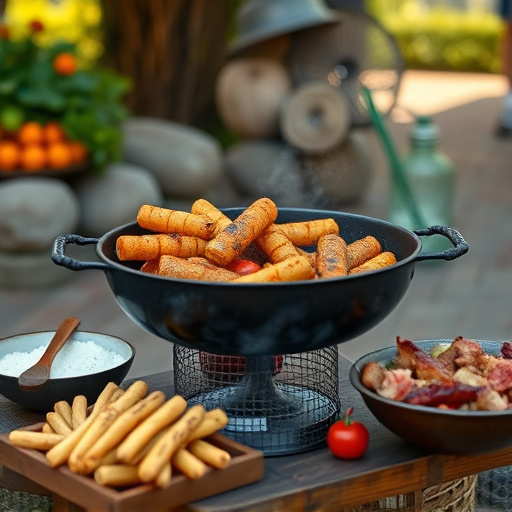Selecting the perfect cut of grass-fed beef is key to making exceptional BBQ beef jerky. Marinating lean cuts like flank steak or sirloin in a spice mix for several hours intensifies flavor. Choose between spicy and sweet jerky based on personal preference and occasion. Drying techniques, from traditional air-drying over an open flame to modern dehydrators, determine the final texture. Store homemade BBQ beef jerky airtight at room temperature for up to 2-3 weeks. Customize marinades with BBQ sauce, soy sauce, garlic, paprika, peppercorns, salt, sugar, honey, or chili powder for unique flavors. Pair your creation with drinks like beer, whiskey, red wine, or cocktails for a symphony of tastes.
Discover the art of crafting mouthwatering, flavorful beef jerky—a versatile snack perfect for any occasion. From selecting premium cuts of beef to mastering drying techniques, this guide explores everything you need to know to create a delicious BBQ beef jerky recipe. Learn about effective marinating methods, balancing spicy and sweet profiles, and creative serving ideas. Plus, find out how to store your jerky properly and even try DIY tips for customizing your own BBQ beef jerky masterpiece.
- Selecting the Perfect Beef for Jerky: Quality Matters
- The Art of Marinading: Infusing Flavor
- Spicy vs. Sweet: Picking Your Preferred Profile
- Drying Techniques: Achieving the Right Texture
- Snacking Beyond the Plate: Creative Ways to Serve
- Pairing Jerky with Drinks: A Taste Symphony
- Storage and Shelf Life: Keeping It Fresh
- DIY Tips: Customizing Your BBQ Beef Jerky Recipe
Selecting the Perfect Beef for Jerky: Quality Matters
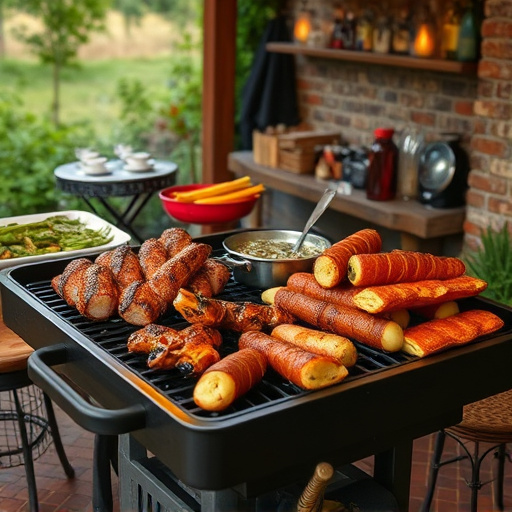
When crafting the perfect BBQ beef jerky, selecting the right cut of meat is paramount. Quality beef is the cornerstone of an exceptional jerky experience. Opt for well-marbled cuts like brisket or flank steak, as these contain a rich blend of lean and fat, ensuring both flavor and tenderness. Fat content plays a crucial role in the jerky’s final texture—too little, and it may become tough; too much can result in an overly greasy product. A balanced cut will yield a satisfying snack with the right amount of chewiness and mouthwatering taste.
Focusing on source is equally vital. Choose grass-fed beef whenever possible, as this ensures higher quality and more natural flavors. The process of selecting and preparing the meat should be just as meticulous as any BBQ beef jerky recipe. After all, the foundation of a delicious snack lies in the quality of its ingredients.
The Art of Marinading: Infusing Flavor
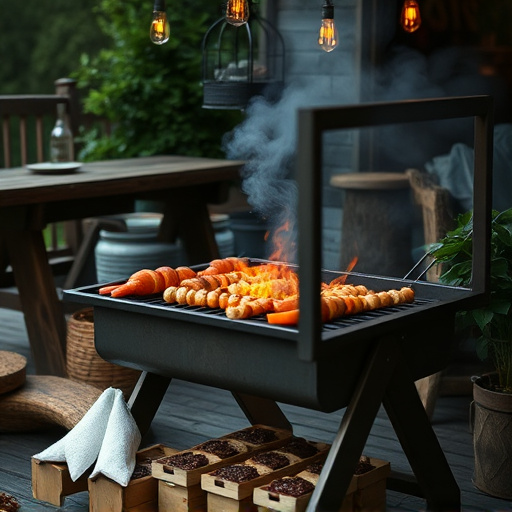
The art of marinading is a key step in creating flavorful bbq beef jerky suitable for any occasion. It involves submerging meat in a mixture of spices, acids, and other flavorings to penetrate and enhance its natural taste. A well-crafted marinade can transform simple beef slices into a delightful culinary experience. For those seeking a mouthwatering BBQ beef jerky recipe, the process begins with selecting high-quality, lean beef cuts like flank steak or sirloin. These proteins provide an excellent base for absorption. Next, combine your favorite spices – think paprika, garlic powder, salt, and pepper – with a liquid base such as soy sauce, vinegar, or even fruit juices. Letting the meat sit in this marinade for several hours allows flavors to deeply infuse. Some chefs even opt for longer durations to achieve an intense, complex taste profile.
Spicy vs. Sweet: Picking Your Preferred Profile
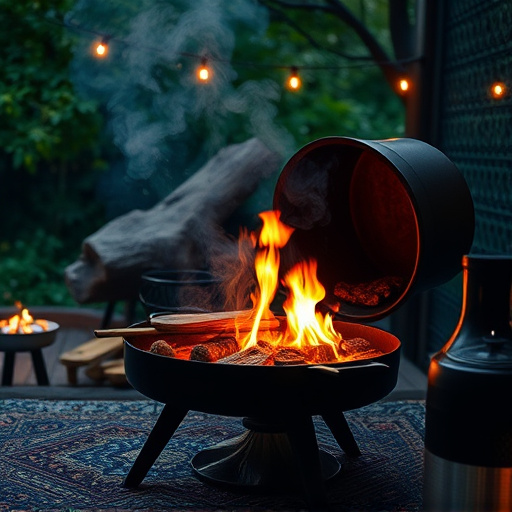
When it comes to flavoring beef jerky, one of the most debated choices revolves around the spice versus sweetness spectrum. This classic clash in taste preferences extends beyond just snacks; it’s a culinary dilemma that influences everything from BBQ beef jerky recipes to gourmet store aisles. Spicy jerky, with its fiery kick, appeals to those who savor the thrill of heat and the complex undertones it adds to each bite. On the other hand, sweet varieties, often infused with honey, maple syrup, or fruit juices, offer a contrasting delight for those who prefer their snacks more sugary and less spicy.
Choosing between these profiles is deeply personal, dictating not just taste but also occasion. Spicy jerky pairs wonderfully with robust beers at outdoor events or as an energizing pick-me-up during workouts. Sweet varieties, however, might be the better choice for family gatherings, where a more mild flavor can appeal to a broader audience, from kids to grandparents. Consider your crowd and the setting – whether it’s a casual get-together or a seasoned adventure – when deciding between these two delicious options in your next beef jerky endeavor.
Drying Techniques: Achieving the Right Texture
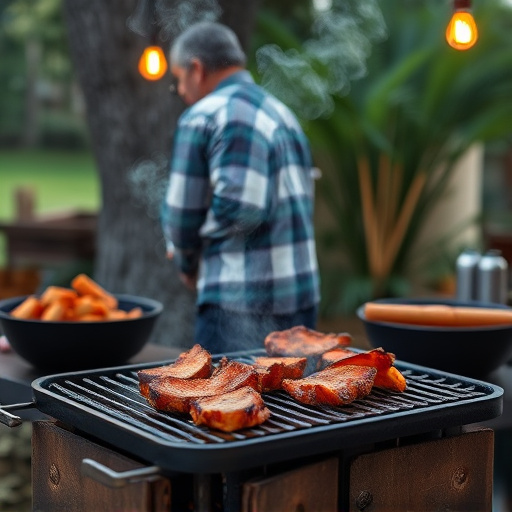
The art of making BBQ beef jerky involves a meticulous process, and one of the key aspects is mastering the drying techniques to achieve that perfect texture. Traditionally, jerky has been air-dried over an open flame, a method that requires precision and patience. This slow-drying process not only preserves the meat but also infuses it with a smoky flavor, making it suitable for outdoor adventures or as a convenient snack on any occasion.
Modern innovations have introduced various techniques, including commercial dehydrators and oven drying, which offer more control over temperature and humidity. For a DIY approach, using an oven at a low temperature setting allows for precise drying while locking in the meat’s natural juices, resulting in tender, flavorful BBQ beef jerky that can be enjoyed anytime, anywhere.
Snacking Beyond the Plate: Creative Ways to Serve
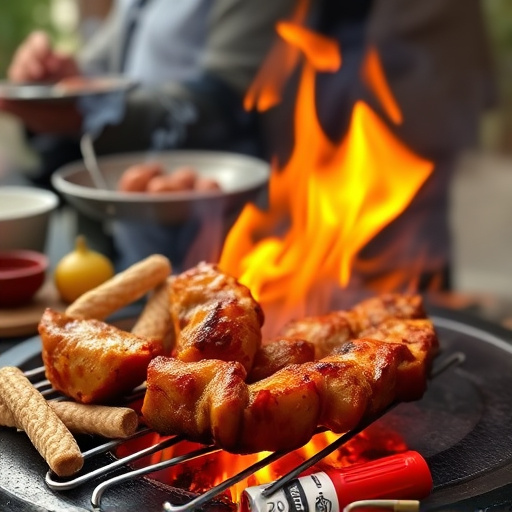
Pairing Jerky with Drinks: A Taste Symphony

When it comes to pairing your favorite bbq beef jerky recipes with drinks, the possibilities are endless for creating a taste symphony. Start with classic combinations like a crisp, cold beer—the carbonation cuts through the chewy texture and bold flavors of the jerky—or a rich, smooth whiskey, which complements the smoky notes in the meat. For a refreshing twist, consider pairing your jerky with a well-crafted cocktail, such as a spicy margarita or an herb-infused gin and tonic. These drink options enhance the overall dining experience by balancing and accentuating the various tastes of the jerky.
Experimenting with different beverages can transform a simple snack into a culinary adventure. For instance, the tangy notes in a robust red wine can beautifully contrast the savory jerky, while a zesty lemon-based drink refreshes your palate between bites. Whether you’re enjoying a casual get-together or a sophisticated dinner party, offering a variety of drink pairings ensures that every guest finds their perfect match, making any occasion memorable and flavorful.
Storage and Shelf Life: Keeping It Fresh

Storage and shelf life are crucial factors in maintaining the freshness and quality of your BBQ beef jerky, especially if you’re preparing a homemade bbq beef jerky recipe. Store jerky in an airtight container at room temperature to preserve its flavor and texture. A cool, dark place like a pantry or cupboard is ideal, as extreme heat and light can degrade the product quickly. Once opened, it’s best to transfer the jerky to a resealable bag and consume within 2-3 weeks for optimal taste. Proper storage ensures that each occasion, whether it’s a casual get-together or a family gathering, can enjoy this delicious treat at its peak.
DIY Tips: Customizing Your BBQ Beef Jerky Recipe
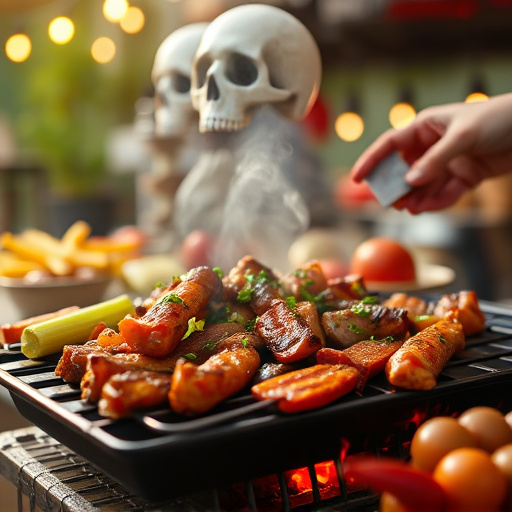
Creating your own BBQ beef jerky at home allows for endless customization, ensuring it’s perfect for any occasion. Start with a basic marinade consisting of your favorite BBQ sauce, soy sauce, garlic, and spices like paprika, peppercorns, and salt. Adjust ingredient quantities to taste, adding a touch of brown sugar or honey for sweetness or chili powder for heat. Soak your beef slices in the marinade for several hours or overnight in the refrigerator. This step is crucial for infusing flavors deep into the meat.
After marinating, dry the beef thoroughly before slicing it thinly. You can experiment with different cutting techniques to achieve varying textures and bite sizes. Next, arrange the thin slices on a dehydrator tray, ensuring they don’t overlap. Dehydrate the jerky at a low temperature until it becomes firm but not brittle. Keep an eye on it to prevent burning. Once done, store your homemade BBQ beef jerky in airtight containers for up to a month, or experiment with different marinades and drying times to create unique flavors suitable for any occasion.
